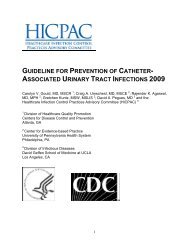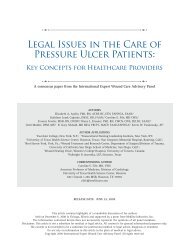SECT2.05 - Recommended Practices for Electrosurgery - Medline
SECT2.05 - Recommended Practices for Electrosurgery - Medline
SECT2.05 - Recommended Practices for Electrosurgery - Medline
- No tags were found...
You also want an ePaper? Increase the reach of your titles
YUMPU automatically turns print PDFs into web optimized ePapers that Google loves.
RP: <strong>Electrosurgery</strong>X.a.3.X.a.4.X.a.5.X.b.Smoke evacuation units and accessoriesshould be used according to manufacturers’written instructions.Detectable odor during the use of asmoke evacuation system is a signal that• smoke is not being captured at thesite where the plume is being generated,• inefficient air movement through thesuction or smoke evacuation wand isoccurring, or• the filter has exceeded its usefulnessand should be replaced. 93When a minimal amount of plume isgenerated, a central suction system withan in-line ULPA filter may be used toevacuate the plume. 92 The in-line filtershould be placed between the suctionwall/ceiling connection and the suctioncanister. 99Central suction units are designed tocapture liquids and should not be usedwithout an in-line ULPA filter to removeairborne contaminants. 92 Low suctionrates associated with centralized suctionunits limit their efficiency in evacuatingplume, making them suitable only<strong>for</strong> the evacuation of small amounts ofplume. 94When a centralized system dedicated<strong>for</strong> smoke evacuation is available, thesmoke evacuator lines should beflushed according to the manufacturer’sinstructions to ensure particulate matterbuildup does not occur.Plume particulate can accumulate inthe lumens of the centralized systemcausing decreased suction capabilityand potential pathogen growth.Used smoke evacuator filters, tubing, andwands should be disposed of as potentiallyinfectious waste following standard precautions.93,99Airborne contaminants produced duringelectrosurgery or laser procedures have beenanalyzed and are shown to contain gaseoustoxic compounds, bio-aerosols, and deadand living cell material. At some level, thesecontaminants have been shown to have anunpleasant odor, cause visual problems <strong>for</strong>X.c.physicians, cause ocular and upper respiratorytract irritation, and demonstrate mutagenicand carcinogenic potential. 99 The possibility<strong>for</strong> bacterial and/or viral contaminationof smoke plume remains controversial buthas been highlighted by different studies. 100,101Personnel should wear high-filtration surgicalmasks during procedures that generatesurgical smoke.High-filtration masks are specificallydesigned to filter particulate matter that is 0.1micron in size and larger which may protectagainst residual plume in the air that hasescaped smoke evacuation capture. 95 Thesemasks should not be viewed as absolute protectionfrom chemical or particulate contaminantsfound in surgical smoke and shouldnot be used as the first line of protectionagainst surgical smoke inhalation. 95,99Recommendation XIPersonnel should receive initial education and competencyvalidation on procedures and shouldreceive additional training when new equipment,instruments, supplies, or procedures are introduced.Initial education on the underlying principles ofelectrosurgical safety provides direction <strong>for</strong> personnelin providing a safe environment. Additional, periodiceducational programs provide rein<strong>for</strong>cement ofprinciples of electrosurgery and new in<strong>for</strong>mation onchanges in technology, its application, compatibilityof equipment and accessories, and potential hazards.Electrosurgical equipment and accessories havebeen associated with numerous fires and patientinjuries. 2,8,19,53 The National Fire Protection Associationhas identified ESUs as high-risk equipment,warranting training and retraining of personnel. 19XI.a. Personnel working with electrosurgeryequipment should be knowledgeable aboutthe principles of electrosurgery, risks topatients and personnel, measures to minimizethese risks, and corrective actions toemploy in the event of a fire or injury. 19Electrosurgical equipment and accessorieshave been associated with numerousfires and patient injuries. 2,8XI.b. Personnel should be instructed on theproper operation, care, and handling of theESU and accessories be<strong>for</strong>e use. 192012 Perioperative Standards and <strong>Recommended</strong> <strong>Practices</strong> Equipment and Product Safety 111
















